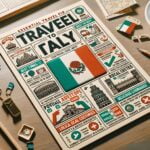Are you seeking advice on travel to Italy? Look no further. Italy is a must-visit travel destination for anyone seeking rich history, beautiful landscapes, and world-renowned cuisine.
From the iconic ruins of Rome to the romantic canals of Venice, Italy offers an unforgettable experience for every traveler. In this article, we will provide you with a comprehensive guide to navigating the ins and outs of traveling in Italy, including tips on when to visit, top destinations to explore, cultural etiquette, transportation options, packing advice, safety precautions, and more.
Italy boasts a diverse range of attractions that cater to every type of traveler. Whether you’re passionate about art and architecture or simply craving delicious Italian cuisine, there’s something for everyone in this stunning country. By diving into each aspect of your trip – from planning your itinerary to understanding the local customs and traditions – you can ensure that your experience in Italy is nothing short of spectacular.
With our expert recommendations and insider tips on everything from dining etiquette to avoiding common scams, you’ll be well-prepared to embark on a truly unforgettable journey through Italy. So get ready to immerse yourself in la dolce vita as we guide you through all the essential aspects of traveling in Italy.
Best Time to Visit Italy
When planning a trip to Italy, one of the most important factors to consider is the best time to visit. The timing of your visit can greatly affect your experience, from the weather and crowds to special events and festivals. Here are some important considerations for determining the best time to visit Italy.
Weather
Italy experiences a diverse range of climates depending on the region, but generally, the best time to visit in terms of weather is during the spring (April to June) and fall (September to October). During these seasons, you can expect mild temperatures, blooming flowers, and comfortable weather for exploring outdoor attractions.
Crowds
The summer months, particularly July and August, are peak tourist season in Italy. This means that popular destinations like Rome, Florence, and Venice will be crowded with tourists, lines for attractions will be longer, and prices for accommodations will be higher. If possible, try to avoid visiting during this time if you prefer a less crowded experience.
Events
Italy is known for its vibrant festivals and events throughout the year. From Carnevale in Venice to Siena’s Palio horse race, there are plenty of unique experiences to enjoy. Researching and planning your trip around these events can add an extra layer of enjoyment to your journey through Italy.
Ultimately, the best time to visit Italy depends on your personal preferences and priorities. Whether you prioritize favorable weather or avoiding crowds, taking these factors into account will help you plan a more enjoyable and memorable trip. For more advice on travel to Italy including tips on transportation options or cultural etiquette dos and don’ts when interacting with Italians check out our other articles.
Top Destinations in Italy
When planning a trip to Italy, it’s important to consider the various top destinations that this beautiful country has to offer. From the historical landmarks of Rome to the picturesque canals of Venice, there are countless places to explore in Italy. Here are some of the top destinations that should not be missed when visiting this enchanting country.
Rome: The Eternal City
Rome is a city steeped in history and is a must-visit destination for anyone traveling to Italy. With iconic landmarks such as the Colosseum, Pantheon, and Trevi Fountain, Rome offers a glimpse into the ancient world while also boasting a vibrant modern culture. Visitors should be sure to explore the Vatican City, home to St. Peter’s Basilica and the Sistine Chapel, as well as indulge in mouthwatering Italian cuisine at local trattorias and gelaterias.
Florence: Birthplace of the Renaissance
Florence is renowned for its stunning art and architecture, making it a haven for art enthusiasts and history buffs alike. The Uffizi Gallery houses masterpieces by Michelangelo, Da Vinci, and Botticelli, while the Florence Cathedral is an architectural marvel that cannot be missed. Travelers can also stroll across the Ponte Vecchio bridge or hike up to Piazzale Michelangelo for panoramic views of this charming city.
Venice: The Floating City
Venice is unlike any other city in the world, with its network of canals and enchanting gondola rides. Visitors can wander through St. Mark’s Square, visit the Doge’s Palace, and admire the intricate mosaics inside St. Mark’s Basilica. Exploring the narrow alleyways and crossing over its iconic bridges like Rialto Bridge offers a unique way to experience this one-of-a-kind city.
These are just a few of the many captivating destinations that Italy has to offer – each with its own distinctive charm and allure. Whether you’re captivated by history, art or culinary delights, Italy has something for every type of traveler seeking an unforgettable experience in this mesmerizing country.
Italian Cuisine
Italy is known worldwide for its delicious and diverse cuisine. From pasta to pizza, gelato to espresso, the country offers a wide array of mouthwatering dishes that are a must-try for anyone visiting Italy. Dining in Italy is also an experience in itself, with unique etiquette and traditions that are important to be aware of when enjoying a meal in this culinary paradise.
One of the most iconic Italian dishes is pasta, and there are countless varieties to try across the country. From classic spaghetti carbonara in Rome to hearty Bolognese in Bologna, each region of Italy has its own signature pasta dish that should not be missed. Seafood lovers will also delight in the fresh fish and seafood found along the coastal regions, while cheese enthusiasts can indulge in the rich flavors of Parmigiano-Reggiano and mozzarella.
When dining in Italy, it’s important to remember that Italians take their food seriously. It’s considered rude to ask for any kind of substitution or modification to a dish, as chefs take great pride in their creations.
Additionally, it’s customary to linger over meals and enjoy multiple courses, so don’t rush through your dining experience. And of course, always remember to greet your server with a friendly “buongiorno” or “buonasera” and thank them with a genuine “grazie” at the end of your meal for a truly authentic Italian dining experience.
For those seeking advice on travel to Italy, exploring the local cuisine is an essential part of immersing oneself in the culture and traditions of this beautiful country. Whether savoring a simple yet perfect margherita pizza in Naples or indulging in a decadent tiramisu in Venice, experiencing Italian cuisine is sure to create lasting memories for any traveler.
Transportation in Italy
Italy offers a variety of transportation options for travelers to explore the country efficiently and comfortably. Whether you want to travel between cities or within the bustling metropolises, here are some essential tips for getting around in Italy:
- Trains: Italy has an extensive and reliable train system that connects major cities as well as smaller towns. The primary railway company, Trenitalia, offers high-speed trains like Frecciarossa and regional trains that provide easy access to various destinations. It is advisable to book tickets in advance, especially during peak seasons, to secure seats and take advantage of discounted fares.
- Rental Cars: Renting a car can be a convenient option for exploring rural areas and scenic countryside regions. However, driving in cities like Rome or Florence can be challenging due to narrow streets, traffic congestion, and limited parking spaces. It is crucial to familiarize yourself with Italian traffic regulations and have an international driver’s permit if necessary.
- Public Transportation: Most major Italian cities have efficient public transportation systems consisting of buses, trams, and metro lines. For example, in Rome, visitors can purchase a Roma Pass that provides unlimited access to public transport along with admission to popular attractions. Additionally, mobile apps like Moovit or Google Maps offer real-time information on routes and schedules.
When traveling in Italy, it is important to consider the pros and cons of each transportation mode based on your itinerary and personal preferences. With careful planning and research, navigating through Italy can be both enjoyable and stress-free.
Similarly noteworthy is the fact that traveling by train not only offers convenience but also affords breathtaking views of Italy’s diverse landscapes. For those keen on immersing themselves in the picturesque scenery while en route to their next destination, opting for train travel is highly recommended.
Moreover should you choose public transportation as your main mode of getting around Italian cities such as Florence or Venice; invest in multi-day passes for added savings on fares. These passes usually provide unlimited rides within a specified timeframe which can be incredibly cost-effective when exploring urban areas with frequent stops at museums, restaurants or tourist hotspots.
Lastly renting a car may grant you flexibility when venturing off the beaten path; however do take note that many historic town centers have restricted vehicle access hence it’s advisable to park outside these zones then continue on foot or via alternate modes like shuttle buses or water taxis where applicable.”.
Cultural Etiquette
When traveling to Italy, it’s important to be aware of the cultural dos and don’ts for interacting with Italians. Italians take great pride in their culture and traditions, so being respectful and mindful of these cultural etiquettes can enhance your travel experience.
One important piece of advice on travel to Italy is to greet people with a handshake, especially when meeting them for the first time. It’s also common to greet friends and acquaintances with a kiss on both cheeks, so be prepared for this customary gesture.
Another cultural etiquette to keep in mind is the concept of “la bella figura,” which translates to “the beautiful figure.” This refers to the importance of presenting oneself well in public, whether it’s through appearance, behavior, or social interactions. As a visitor in Italy, it’s advisable to dress neatly and avoid clothing that may be considered too casual or sloppy. Taking care of your appearance shows respect for the Italian culture and its emphasis on elegance and style.
When dining in Italy, there are certain customs that are important to observe. For example, it’s common practice to wait for everyone at the table to be served before starting your meal. Additionally, expressing appreciation for the food by complimenting the chef or host is considered polite.
It’s also customary to use utensils while eating rather than eating with your hands unless you’re at a traditional pizzeria where slicing a pizza with a knife and fork may not be necessary. Following these dining etiquettes will show your respect for Italian customs and traditions.
Overall, understanding and respecting Italian cultural etiquettes can greatly enhance your travel experience in Italy. By familiarizing yourself with these dos and don’ts for interacting with locals, you’ll be able to immerse yourself more deeply into the rich cultural fabric of Italy and create meaningful connections with its people.
Packing Tips
Italy is a beautiful and diverse country, rich in culture, history, and natural beauty. When planning a trip to Italy, it’s important to consider what to pack in order to make the most of your experience. Packing light is key when traveling through the cobbled streets of historic towns and cities, as well as navigating the crowded public transportation system.
First and foremost, comfortable walking shoes are essential for exploring Italy’s many attractions. With countless museums, churches, and ancient ruins to visit, comfortable footwear is a must. Additionally, lightweight clothing that can easily be layered is ideal for unpredictable weather conditions. In the summer months, breathable fabrics are necessary to combat high temperatures.
Another important item to bring is a universal adapter for charging devices. Italian plugs are different from those used in other countries, so having an adapter will ensure that you can keep your phone, camera, and other electronics powered up throughout your trip. It’s also a good idea to bring a small daypack for carrying essentials during day trips and city walks.
It’s important to note that certain items should be left at home when traveling to Italy. Flashy jewelry and expensive accessories can make travelers targets for pickpockets in crowded tourist areas. It’s best to leave these items behind and opt for more modest attire while exploring the country.
| Packing Tips | What to Bring | What to Leave at Home |
|---|---|---|
| Comfortable walking shoes | Universal adapter | Flashy jewelry |
| Lightweight clothing | Lightweight daypack | Expensive accessories |
Safety Tips for Traveling in Italy
When traveling to Italy, it is important to be aware of potential scams and safety precautions to ensure a smooth and enjoyable trip. One common scam in popular tourist areas is pickpocketing, so it’s important to keep valuables secure and be cautious in crowded places.
It’s also advisable to be aware of scams involving fake police officers or individuals offering unsolicited help with directions or transportation. To avoid falling victim to these scams, it’s best to only trust official sources for assistance and information.
In terms of health precautions, it’s essential for travelers to have a comprehensive travel insurance policy that includes coverage for medical emergencies. While Italy has excellent healthcare services, foreign visitors may still encounter language barriers and unfamiliar processes. Additionally, it’s recommended to have a basic understanding of the Italian healthcare system and know the location of nearby medical facilities. Travelers should also take necessary precautions such as staying hydrated, wearing sunscreen, and following food and water safety guidelines.
It is wise for travelers to have emergency contacts readily available while in Italy. In case of an emergency, knowing the local equivalent numbers for calling emergency services can be crucial.
It’s also beneficial to have contact information for the nearest embassy or consulate from your home country in case assistance is needed. By being prepared with safety tips and precautionary measures, travelers can minimize potential risks and have a worry-free experience while exploring all that Italy has to offer.
Conclusion
In conclusion, Italy is undeniably a must-visit travel destination for anyone seeking an enriching and unforgettable experience. From the historic landmarks of Rome to the artistic treasures of Florence and the romantic canals of Venice, Italy offers a diverse range of attractions that cater to all types of travelers. Whether you are a history buff, a food enthusiast, or simply someone in search of natural beauty, Italy has something to offer.
When planning your trip to Italy, it’s essential to consider the best time to visit in order to avoid large crowds and extreme weather. Additionally, it’s important to familiarize yourself with Italian cuisine and dining etiquette as well as transportation options within the country. Understanding cultural dos and don’ts when interacting with locals will also enhance your experience.
As you prepare for your journey, remember to pack appropriately and prioritize safety by being aware of common scams and taking necessary health precautions. Finally, immerse yourself in the local culture by learning some basic Italian phrases – it goes a long way in fostering positive interactions with residents. With these final tips and recommendations in mind, you are sure to have a truly memorable trip to Italy.
Frequently Asked Questions
Is Italy Safe to Travel to Right Now?
Italy is generally safe to travel to right now, but it is important to stay informed about any travel advisories or safety concerns. As with any destination, it’s essential to exercise caution and be aware of your surroundings.
What Do I Need to Know About Traveling to Italy?
When traveling to Italy, it’s important to be aware of the local customs and etiquette. It’s also crucial to have a basic understanding of the Italian language, as well as knowledge of the currency and transportation options. Additionally, being mindful of popular tourist scams and staying updated on any travel restrictions is advisable.
What Is Required for a US Citizen to Visit Italy?
For a US citizen to visit Italy, a valid passport is required for entry into the country. While a visa is not needed for short visits, travelers should ensure their passport has at least six months validity beyond their planned departure date from Italy. It’s also recommended to have travel insurance coverage for the duration of the trip.

I’m a passionate traveler, writer, and Italophile. My fascination with Italy’s history, art, and culture has led me on countless adventures across the Italian landscape. Through “I Live Italy,” I share my love for this extraordinary country and aims to inspire others to explore its boundless beauty.





